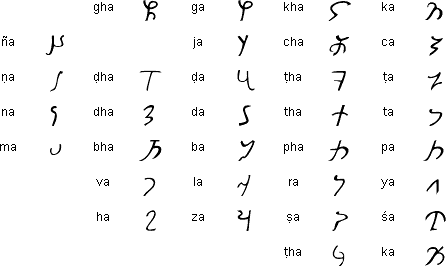The Kharosthi, or Kharoṣṭhī, script was invented sometime during the 3rd century BC, and was possibly derived from the Aramaic script. It was used in Gandhara, an ancient kingdom in what is now the northwest of Pakistan, and the Jalalabad district of Afghanistan. Kharosthi texts have also been found along the Silk Road in Bactria, Kushan, Sogdia, and in parts of China.
By the 4th century AD the script was no longer used in Gandhara, but may have been used until the 7th centuries in places such as Khotan / Hotan (和田), in what is now Xinjiang in the northeast of China.
Kharosthi has no known descendants, although it is possible that the Old Turkic (Orkhon) script may have developed from Kharoshthi.
Kharoshti was deciphered during the 19th century by James Prinsep, Christian Lassen, C.L. Grotefend and Edwin Norris. Bilingual inscriptions in Gandhari and Greek on coins helped with the decipherment. Since then further material has been found and the script is now better understood.
Gandhari, of Gāndhārī, a Prakrit language used in inscriptions in the Kharosthi script between the 3rd century BC and the 4th century AD, and possibly until the 7th century AD.
Sanskrit (संस्कृतम्), a classical language of India, which is still used as a religious and ceremonial language, and as a spoken language to some extent.
Pali (पालि), the classical language of Theravada Buddhism that was first used in Sri Lanka during the 1st century BC.



Information about Kharosthi and Gandhara
https://en.wikipedia.org/wiki/Kharosthi
https://en.wikipedia.org/wiki/Gāndhārī_language
https://www.ancient.eu/Kharosthi_Script/
http://www.ancientindia.co.uk/writing/explore/b_kharosthi.html
http://depts.washington.edu/ebmp/software.html
http://std.dkuug.dk/jtc1/sc2/wg2/docs/n2524.pdf
http://depts.washington.edu/ebmp/downloads/Glass_2000.pdf
https://depts.washington.edu/silkroad/texts/niyadocts.html
ALPHABETUM - a Unicode font
for ancient scripts, including Classical & Medieval Latin, Ancient Greek, Etruscan, Oscan, Umbrian, Faliscan, Messapic, Picene, Iberian, Celtiberian, Gothic, Runic, Old & Middle English, Hebrew, Sanskrit, Old Nordic, Ogham, Kharosthi, Glagolitic, Anatolian scripts, Phoenician, Brahmi, Imperial Aramaic, Old Turkic, Old Permic, Ugaritic, Linear B, Phaistos Disc, Meroitic, Coptic, Cypriot and Avestan.
https://www.typofonts.com/alphabetum.html
Bhaiksuki, Brāhmi, Devanāgari, Galik, Grantha, Gupta, Kadamba, Kharosthi, Nandinagari, Sharda, Siddham, Thai, Tibetan
Ahom, Aima, Arleng, Badagu, Badlit, Basahan, Balinese, Balti-A, Balti-B, Batak, Baybayin, Bengali, Bhaiksuki, Bhujimol, Bilang-bilang, Bima, Blackfoot, Brahmi, Buhid, Burmese, Carrier, Chakma, Cham, Cree, Dehong Dai, Devanagari, Dham Lipi, Dhankari / Sirmauri, Ditema, Dives Akuru, Dogra, Ethiopic, Evēla Akuru, Fox, Fraser, Gond, Goykanadi, Grantha, Gujarati, Gunjala Gondi, Gupta, Gurmukhi, Halbi Lipi, Hanifi, Hanuno'o, Hočąk, Ibalnan, Incung, Inuktitut, Jaunsari Takri, Javanese, Kaithi, Kadamba, Kamarupi, Kannada, Kawi, Kharosthi, Khema, Khe Prih, Khmer, Khojki, Khudabadi, Kirat Rai, Kōchi, Kodava Lipi, Komering, Kulitan, Kurukh Banna, Lampung, Lanna, Lao, Lepcha, Limbu, Lontara/Makasar, Lota Ende, Magar Akkha, Mahajani, Malayalam, Meitei (Modern), Manpuri (Old), Marchen, Meetei Yelhou Mayek, Meroïtic, Masarm Gondi, Modi, Mon, Mongolian Horizontal Square Script, Multani, Nandinagari, Newa, New Tai Lue, Ojibwe, Odia, Ogan, Pahawh Hmong, Pallava, Phags-pa, Purva Licchavi, Qiang / Rma, Ranjana, Rejang (Kaganga), Sasak, Savara, Satera Jontal, Shan, Sharda, Sheek Bakrii Saphaloo, Siddham, Sinhala, Sorang Sompeng, Sourashtra, Soyombo, Sukhothai, Sundanese, Syloti Nagri, Tagbanwa, Tai Noi, Takri, Tamil, Tanchangya (Ka-Pat), Tani, Thaana, Telugu, Thai, Tibetan, Tigalari, Tikamuli, Tocharian, Tolong Siki, Vatteluttu, Warang Citi
Page last modified: 15.03.23
[top]
You can support this site by Buying Me A Coffee, and if you like what you see on this page, you can use the buttons below to share it with people you know.

If you like this site and find it useful, you can support it by making a donation via PayPal or Patreon, or by contributing in other ways. Omniglot is how I make my living.
Note: all links on this site to Amazon.com, Amazon.co.uk
and Amazon.fr
are affiliate links. This means I earn a commission if you click on any of them and buy something. So by clicking on these links you can help to support this site.
[top]